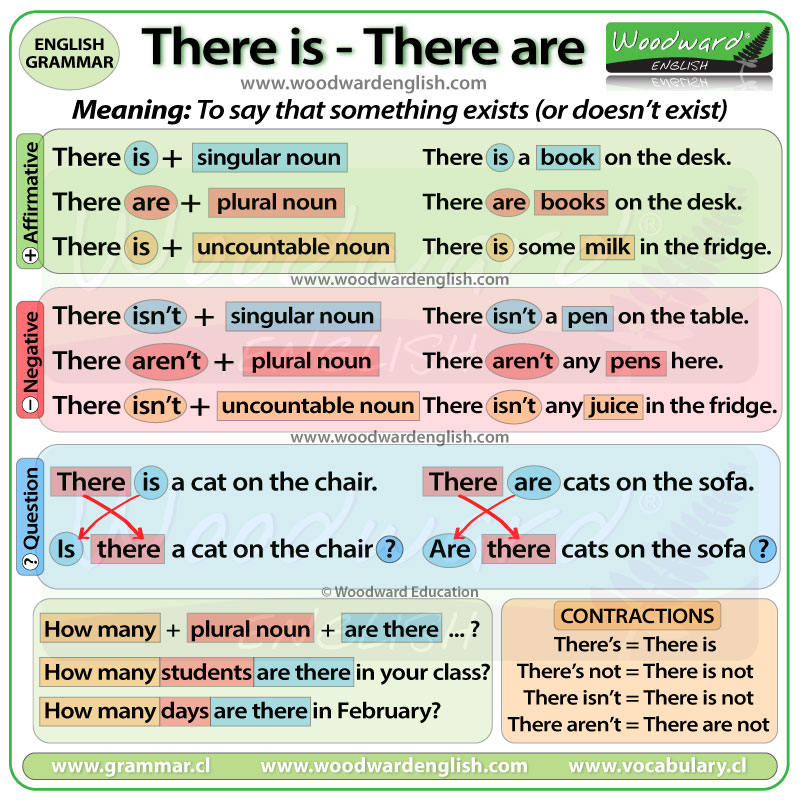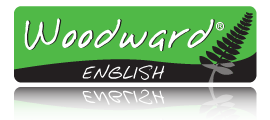There is / There are
There is / There are = something exists.
There is + singular noun
There are + plural noun
- There is a book on the table. (One book = singular)
- There are two books on the table. (Two books = plural)
- There are some books on the table. (We don’t specify the number BUT more than one)
There is a problem. = A problem exists … one problem (singular)
And for two problems? What do we say?
We use There are with plural nouns so it becomes:
- There are two problems. (two problems exist = plural)
- There are some problems. = I do not specify the number of problems so I use SOME
- There are many problems. = Many problems exist = a large number of problems
More example sentences with There is and There are:
- There is a person at the bus stop.
- There are people at the bus stop.
- There is a picture on the wall.
- There is a good movie on TV tonight.
- There are seven days in a week.
- There are thirty-one-days in January.
- There are three people in this room.
There is + uncountable noun
When we have an uncountable noun, the general word order is:
There is + (some/a lot of) + uncountable nouns
- There is some sugar in the jar. (You cannot count sugar so it is an uncountable noun)
- There is some milk in the fridge. (Milk is an uncountable noun)
- There is some ice cream on your t-shirt.
- There is a lot of traffic today. (a lot = a large amount, a large quantity)
- There is a lot of water on the floor. (we use IS because water is uncountable)
Complete these sentences with There is or There are
- There _____ a hospital near my house.
- There _____ twelve months in a year.
- There _____ many people at the concert.
- There _____ some juice in the fridge.
- There _____ some boats on the lake.
- There _____ a letter for you.
- There _____ a great restaurant on High Street.
- There _____ three windows in this room.
Negative Sentences with There is and There are
How do we say that something does NOT exist?
How do we make the negative of there is and there are?
We add NOT after IS and ARE.
- There is not
- There are not
When we are speaking, we normally use a contraction of these words:
- There is not … becomes … there isn’t.
- There are not … becomes … there aren’t.
There isn’t / There aren’t = something does NOT exist.
- There is a book on the table. (This is an affirmative sentence)
Can you see a pen on the table? No! So we say:
- There isn’t a pen on the table. (This is a negative sentence)
Now this sentence:
- There are some books on the table. (This is an affirmative sentence)
We don’t specify the number, so we use SOME.
Can you see any pens on the table? No!
- There aren’t any pens on the table. (This is a negative sentence)
Remember, we use ANY in negative sentences and not SOME.
The same happens with uncountable nouns.
We use: There isn’t + uncountable noun
- There is some milk in the fridge. (an affirmative sentence)
- There isn’t any juice in the fridge. (a negative sentence)
Remember, we use ANY in negative sentences and not SOME.
Let’s see some more examples with uncountable nouns:
- There isn’t any sugar in my coffee. = zero sugar.
- There isn’t any snow in Jamaica. = zero snow.
- There isn’t any money in my wallet. = zero money.
Questions with There is and There are
- There is a table in the room. (This is an affirmative sentence)
This is to say that something exists in the room. What exists? A table.
BUT, How can we change this affirmative sentence and make it a question?
How can we ASK if something exists or is available?
We change the order of There is and There are to make a question.
- There is a table in the room. (an affirmative sentence)
We change the order of THERE and IS and it becomes IS THERE …?
- Is there a table in the room? (This is a question)
With this affirmative sentence:
- There are some books on the table.
To make this a question we change the order of THERE and ARE and we say:
- Are there any books on the table?
Notice how we changed SOME to ANY because in general we use SOME in affirmative sentneces and ANY in questions.
Now, how can we answer these questions?
The most common way is to use short answers:
- Is there a table in the room?
- Yes, there is.
- No, there isn’t … OR … No, there’s not.
- Are there any books on the table?
- Yes, there are.
- No, there aren’t
How many + Plural Noun + are there?
When you want to know the QUANTITY or NUMBER of something, you use:
How many + Plural Noun + are there?
- How many tables are there in the room?
- There is one. … OR … There is one table in the room.
You can also say: There’s one.
There’s is a contraction of There is which is used a lot in spoken English.
Yes, the question was with ARE THERE …?
But, if there is only ONE object or thing, we start the answer with There is … There’s one.
And this question:
- How many books are there? (If you want you can say “How many books are there on the table?”)
Answer: There are three. OR There are three books.
There is / There are QUIZ
Here is our English quiz to practice THERE IS and THERE ARE in sentences and questions.
Can you get 20/20 correct?
There is / There are – Woodward English Summary Chart

I hope you enjoyed this English lesson about THERE IS and THERE ARE.
